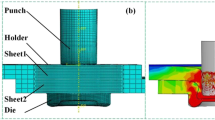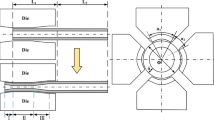Abstract
Clinch joining is a complexed mechanical behavior influenced by both process parameters and geometry parameters. The present clinch joining optimizations are more dedicated on geometry parameters, and except some property objectives of optimization, the other design properties of clinching process are not considered as constrained conditions. Therefore, the multiobjective optimization in the paper takes clinching process parameters such as punch speed, bottom thickness, and blank holder force into consideration besides geometry parameters, and then sets two thinning rates as constrained conditions. In the paper, a sufficient and systemic procedure for high-quality clinched joint based on FEA (finite element analysis), PS (parameter study), RSM (response surface methodology), and NSGA-II (non-dominated sorting genetic algorithm-II) is developed. Parameter study is conducted to choose significant parameters from both process and geometric parameters for neck, interlock, and tensile force. Then, mathematical models of nine selected parameters with responses are built based on RSM, and the interactions on interlock and tensile force are clearly identified by the model. Finally, three objectives neck, interlock, and tensile force and two constraints thinning rates of side face of joint are applied on multiobjective optimization using NSGA-II, which could obtain comprehensive high-quality joint, and the Pareto sets reveal negative relations of both tensile force to neck and interlock to neck, as well as the positive relation between interlock and tensile force. The result shows that the presented procedure performs well in optimization of clinch joining process and the use of finite element simulation model is valuable for complex optimization design.
Similar content being viewed by others
References
Eshtayeh M, Hrairi M, Mohiuddin A (2016) Clinching process for joining dissimilar materials: state of the art. Int J Adv Manuf Technol 82:179–195. https://doi.org/10.1007/s00170-015-7363-0
Mucha J, Kaščák L, Spišák E (2011) Joining the car-body sheets using clinching process with various thickness and mechanical property arrangements. Arch Civil Mech Eng 11(1):135–148. https://doi.org/10.1016/S1644-9665(12)60179-4
Abe Y, Kishimoto M, Kato T, Mori K (2009) Joining of hot-dip coated steel sheets by mechanical clinching. J Mater Process Technol 2(1):291–294. https://doi.org/10.1007/s12289-009-0446-4
Abe Y, Mori K, Kato T (2012) Joining of high strength steel and aluminium alloy sheets by mechanical clinching with dies for control of metal flow. J Mater Process Technol 212(4):884–889. https://doi.org/10.1016/j.jmatprotec.2011.11.015
Abe Y, Kato T, Mori K, Nishino S (2014) Mechanical clinching of ultra-high strength steel sheets and strength of joints. J Mater Process Technol 214(10):2112–2118. https://doi.org/10.1016/j.jmatprotec.2014.03.003
Abe Y, Nihsino S, Mori K, Saito T (2014) Improvement of joinability in mechanical clinching of ultra-high strength steel sheets using counter pressure with ring rubber. Adv Mater Res 81(966–967):2056–2061. https://doi.org/10.1016/j.proeng.2014.10.285
Lambiase F, Ilio AD, Paoletti A (2015) Joining aluminium alloys with reduced ductility by mechanical clinching. Int J Adv Manuf Technol 77(5–8):1295–1304. https://doi.org/10.1007/s00170-014-6556-2
Lambiase F, Ilio AD (2014) An experimental study on clinched joints realized with different dies. Thin-Walled Struct 85:71–80. https://doi.org/10.1016/j.tws.2014.08.004
Hamel V, Roelandt JM, Gacel JN, Schmit F (2000) Finite element modeling of clinch forming with automatic remeshing. Comput Struct 77(2):185–200. https://doi.org/10.1016/S0045-7949(99)00207-2
Varis JP, Lepistö J (2003) A simple testing-based procedure and simulation of the clinching process using finite element analysis for establishing clinching parameters. Thin-Walled Struct 41(8):691–709. https://doi.org/10.1016/S0263-8231(03)00026-0
Lee CJ, Kim JY, Lee SK, Ko DC, Kim BM (2010) Design of mechanical clinching tools for joining of aluminium alloy sheets. Mater Des 31(4):1854–1861. https://doi.org/10.1016/j.matdes.2009.10.064
Lee CJ, Kim JY, Lee SK, Ko DC, Kim BM (2010) Parametric study on mechanical clinching process for joining aluminum alloy and high-strength steel sheets. J Mech Sci Technol 24(1):123–126. https://doi.org/10.1007/s12206-009-1118-5
Mucha J (2011) The analysis of lock forming mechanism in the clinching joint. Mater Des 32(10):4943–4954. https://doi.org/10.1016/j.matdes.2011.05.045
Coppieters S, Lava P, Baes S, Sol H, Houtte PV, Debruyne D (2012) Analytical method to predict the pull-out strength of clinched connections. Thin-Walled Struct 52(1):42–52. https://doi.org/10.1016/j.tws.2011.12.002
Coppieters S, Lava P, Hecke RV, Cooreman S, Sol H, Houtte PV, Debruyne D (2013) Numerical and experimental study of the multi-axial quasi-static strength of clinched connections. Int J Mater Form 6(4):437–451. https://doi.org/10.1007/s12289-012-1097-4
He X, Zhao L, Yang H, Xing B, Wang Y, Deng C, Gu F, Ball A (2014) Investigations of strength and energy absorption of clinched joints. Comput Mater Sci 94(11):58–65. https://doi.org/10.1016/j.commatsci.2014.01.056
Israel M (2014) The suitability of analytical and numerical methods for developing clinching processes with thick sheet metal. Adv Mater Res 907:151–163. https://doi.org/10.4028/www.scientific.net/AMR.907.151
He X, Liu F, Xing B, Yang H, Wang Y, Deng C, Gu F, Ball A (2014) Numerical and experimental investigations of extensible die clinching. Int J Adv Manuf Technol 74:1229–1236. https://doi.org/10.1007/s00170-014-6078-y
Coppieters S, Cooreman S, Sol H, Debruyne D (2007) Reproducing the experimental strength of clinched connections with finite element methods. In: Proceedings of the SEM Annual Conference and Exposition on Experimental and Applied Mechanics. pp. 572–579. DOI:https://doi.org/10.1007/s00170-015-7781-z
Coppieters S, Cooreman S, Lava P, Sol H, Houtte PV, Debruyne D (2011) Reproducing the experimental pull-out and shear strength of clinched sheet metal connections using FEA. Int J Mater Form 4(4):429–440. https://doi.org/10.1007/s12289-010-1023-6
Roux E, Bouchard PO (2013) Kriging metamodel global optimization of clinching joining processes accounting for ductile damage. J Mater Process Technol 213(7):1038–1047. https://doi.org/10.1016/j.jmatprotec.2013.01.018
Xu F, Zhao SD, Han XL (2014) Use of a modified gurson model for the failure behaviour of the clinched joint on al6061 sheet. Fatigue Fracture Engineering Materials Structures 37(3):335–348
Zhao SD, Xu F, Guo JH, Han XL (2014) Experimental and numerical research for the failure behavior of the clinched joint using modified rousselier model. J Mater Process Technol 214(10):2134–2145. https://doi.org/10.1016/j.jmatprotec.2014.03.013
Coppieters S, Zhang H, Xu F, Vandermeiren N, Breda A, Debruyne D (2017) Process-induced bottom defects in clinch forming: simulation and effect on the structural integrity of single shear lap specimens. Mater Des 130:336–348. https://doi.org/10.1016/j.matdes.2017.05.077
Varis J (2006) Ensuring the integrity in clinching process. J Mater Process Technol 174(1–3):277–285. https://doi.org/10.1016/j.jmatprotec.2006.02.001
Paula A, Aguilar M, Pertence A, Cetlin PR (2007) Finite element simulations of the clinch joining of metallic sheets. J Mater Process Technol 182(1):352–357. https://doi.org/10.1016/j.jmatprotec.2006.08.014
He X (2010) Recent development in finite element analysis of clinched joints. Int J Adv Manuf Technol 48(5–8):607–612. https://doi.org/10.1007/s00170-009-2306-2
Jayasekara V, Min KH, Noh JH, Min TK, Seo JM, Lee HY, Hwang BB (2010) Rigid-plastic and elastic-plastic finite element analysis on the clinching joint process of thin metal sheets. Met Mater Int 16(2):339–347. https://doi.org/10.1007/s12540-010-0427-7
Oudjene M, Ben-Ayed L (2008) On the parametrical study of clinch joining of metallic sheets using the taguchi method. Eng Struct 30(6):1782–1788. https://doi.org/10.1016/j.engstruct.2007.10.017
Oudjene M, Ben-Ayed L, Delamézière A, Batoz JL (2009) Shape optimization of clinching tools using the response surface methodology with moving least-square approximation. J Mater Process Technol 209(1):289–296. https://doi.org/10.1016/j.jmatprotec.2008.02.030
Lambiase F, Ilio AD (2013) Finite element analysis of material flow in mechanical clinching with extensible dies. J of Materi Eng Perform 22(6):1629–1636. https://doi.org/10.1007/s11665-012-0451-5
Lambiase F, Ilio AD (2013) Optimization of the clinching tools by means of integrated fe modeling and artificial intelligence techniques. Procedia Cirp 12:163–168. https://doi.org/10.1016/j.procir.2013.09.029
Behrens BA, Bouguecha A, Vucetic M, Hübner S, Yilkiran D, Jin YL, Ilya P (2015) FEA-based optimisation of a clinching process with a closed single-part die aimed at damage minimization in CR240BH-AlSi10MnMg joints. Key Eng Mater 651-653:1487–1492. https://doi.org/10.4028/www.scientific.net/KEM.651-653.1487
Eshtayeh M, Hrairi M (2016) Multi objective optimization of clinching joints quality using grey-based taguchi method. Int J Adv Manuf Technol 87(1–4):1–17. https://doi.org/10.1007/s00170-016-8471-1
Eshtayeh M, Hrairi M (2016) Recent and future development of the application of finite element analysis in clinching process. Int J Adv Manuf Technol 84(9–12):2589–2608. https://doi.org/10.1007/s00170-015-7781-z
Natrella M. (2010) NIST/SEMATECH e-handbook of statistical methods. http://www.itl.nist.gov/div898/handbook/. Accessed 30 October 2013
Acknowledgements
This work is supported by the National Natural Science Foundation of China (Grant No. 51675243) and the National Natural Science Foundation of China (Grant No. 51675241).
Author information
Authors and Affiliations
Corresponding author
Rights and permissions
About this article
Cite this article
Wang, X., Li, X., Shen, Z. et al. Finite element simulation on investigations, modeling, and multiobjective optimization for clinch joining process design accounting for process parameters and design constraints. Int J Adv Manuf Technol 96, 3481–3501 (2018). https://doi.org/10.1007/s00170-018-1708-4
Received:
Accepted:
Published:
Issue Date:
DOI: https://doi.org/10.1007/s00170-018-1708-4




